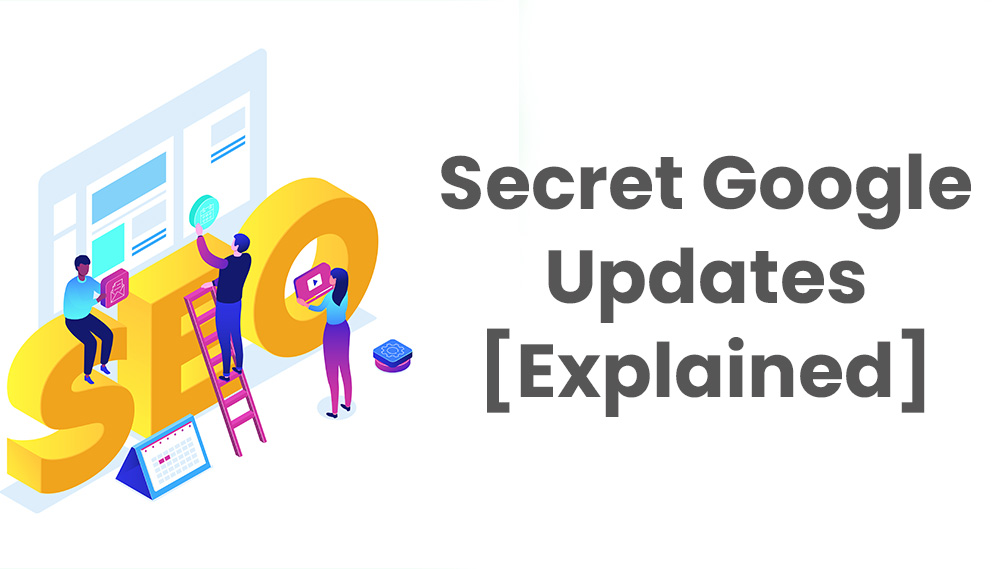Secret Google updates [explained]
Search Engine Optimisation is one of the most popular processes in the digital marketing realm, used by businesses to get great ROIs through what is relatively a cheap process!
However, it’s certainly not easy to grab a top spot on the first page of Google, or any other search engine. This is the main reason why people believe that SEO is ineffective – Let me explain why that isn’t the case.
Consider this: why do some websites rank better than others? And what can you do to land on the first page of SERPs?
The key to optimising your site is to understand the algorithms that run these search engines and decide what gets ranked where.
Google is the most widely used search engine with 79% of all search traffic on the internet, but is greatly feared by marketers for its infamous SEO algorithm updates.
What Are Google Algorithms?
When you type a search query into Google, you get millions of results each time in a matter of seconds. As all of these results cannot fit on the first page, Google has devised a system to prioritise search results for users.
Instead of just using a single algorithm to monitor content, Google uses a number of parallel running algorithms that consider various factors simultaneously to determine rankings.
In fact, there is a list of 200 ranking factors that Google’s bots take into consideration before ranking your pages.
And while we don’t yet know all of these factors (some are known, others are strong speculations by SEO experts), Google has been fairly transparent about how its algorithms work.
Understanding Black Hat SEO
Before we dive into the most popular Google algorithm updates and what they target, let’s first talk about what you shouldn’t do to rank: Try to cheat Google.
Google runs on the motto “Do the right thing,” and comes down hard on anyone who doesn’t follow it’s strict policies and guidelines.
So, if you want to escape Google’s wrath that can lead to low traffic – or being dropped from search results altogether – here are few things to keep in mind: · Don’t use unrelated keywords to catfish web users· Don’t use bot generated comments to make your URL rank higher· Refrain from creating doorway pages
Tactics such as these are designed to trick search engines into ranking you higher on their search pages, and are known as black hat SEO techniques.
While these may help you rank for a while, you won’t be able to escape Google’s notice for long – especially since it keeps rolling out algorithm updates to catch site owners who use black hat SEO to cheat the system.
Google Algorithm Updates Explained
Google has introduced various algorithms to make the search experience more relevant for users. To keep serving quality links, it introduces various updates every 2 months to keep marketers on their toes.
Here is a list of their most popular algorithm updates:
The Panda Update
This was a search algorithm released in 2011 which targeted content quality. To avoid being penalised by Panda – this update – you should:
· Avoid low quality content
· Avoid plagiarism
· Avoid article spinning
The Penguin Update
Penguin is an algorithm that takes two factors into account:
· Backlinks, and
· Keywords
While you may be tempted to buy backlinks for your website, or create multiple low-quality backlinks as a quick fix to your SEO needs, know that Penguin will catch you, and no longer rank you.
Same goes for stuffing your content with keywords; while it is important to have keywords on your webpage to help it rank better, too many of those may make your page look spammy in the eyes of Penguin.
The Hummingbird Update
This update was introduced by Google to better understand their users search intent so they could optimise the search process for them.
While this does not decide search rankings, it helps Google decide if your website and business is actually what users are looking for. If it’s not, then say goodbye to a potentially high ranking on the SERPs.
Google has introduced a number of minor algorithm updates in addition to these – combined, these work together to decide where your website will rank on the search pages.
To fully optimise your content for search engines, specifically Google, the first step is to refrain from adopting black hat SEO techniques that might make Google blacklist you. The second step is to ensure that the content on your site is SEO optimised, and offers value to users.
Refrain from adopting black hat SEO techniques that might make Google blacklist you. The second step is to ensure that the content on your site is SEO optimised, and offers value to users.




